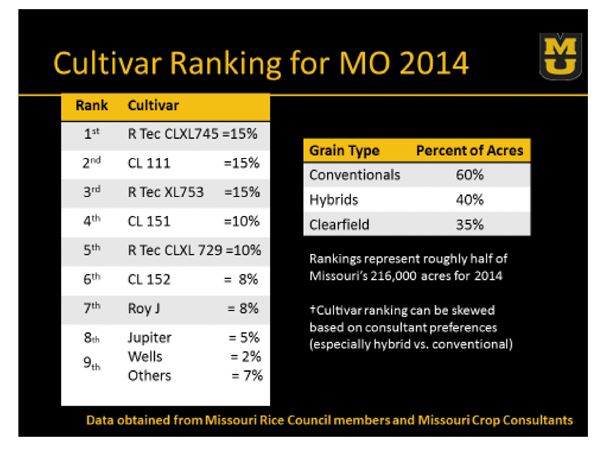Missouri Rice Varieties For 2015
SAM ATWELL
NEW MADRID, MO.
Have you heard that farmers are independent thinkers? Our rice variety data gathering summary taken last week for 2014 certainly reflects the different thinking Missouri farmers have about choosing rice varieties to plant on their farms. They have very good reasons for needing diverse varieties that fit their specific conditions and situations in the ten Mo. counties that grow rice listed on map below. Some want short and some tall, some early and some later. Some want hybrids for better disease resistance and some want the Clearfield weed trait, while some want less expensive seed so they can plant thicker. Some are seeking the best fit for row rice and blast resistance.

We found that their selections were divided between ten varieties and the top five was planted on about sixty five percent of the 216,000 acres in Mo. Since Southeast Missouri is the beginning of the Mississippi Delta, our soils vary greatly from sand to Sharkey Clay. About fifty percent of our soils are clay based with a thin layer of silt. Many Missouri farmers like hybrid rice for these soils where they often see a yield increase over conventional varieties and they like the disease package they get with the hybrids. Others prefer varieties that tend to grade better which may give them a premium price. Most Mo. farmers are concentrating on quality with five percent medium grain with the remaining ninety five percent being long grain. The remaining fifty percent of our soils are either heavy clay or loamy and many growers see conventional varieties a better fit. 2015 offers new varieties for consideration. Missouri has not finished analyzing 2014 variety data and as usual Mo. growers look to the University of Arkansas for rice variety data. We are all looking forward to exciting new varieties from Dr. Beighley's breeding of a medium grain rice at Mo. Rice Council Research Farm (MM-14), LSU and UAR (LaKast) another long grain variety, along with a new herbicide series from Horizon Ag and BASF.
Southeast Missouri is blessed with a very ample supply of fresh, clean, easy to pump, cheap water supply that recharges very quickly. Ninety Seven percent of Mo. rice is flood irrigated, with three percent pivot or furrow. Ninety five percent of our water is pumped from wells with five percent from streams. Ninety five percent is drill or broadcast seeded and five percent water seeded. All of this information causes farmers to choose varieties that best fit their specific situation. (Estimated top varieties in 2014 shown in chart.) ∆
SAM ATWELL: Agronomy Specialist, University of Missouri